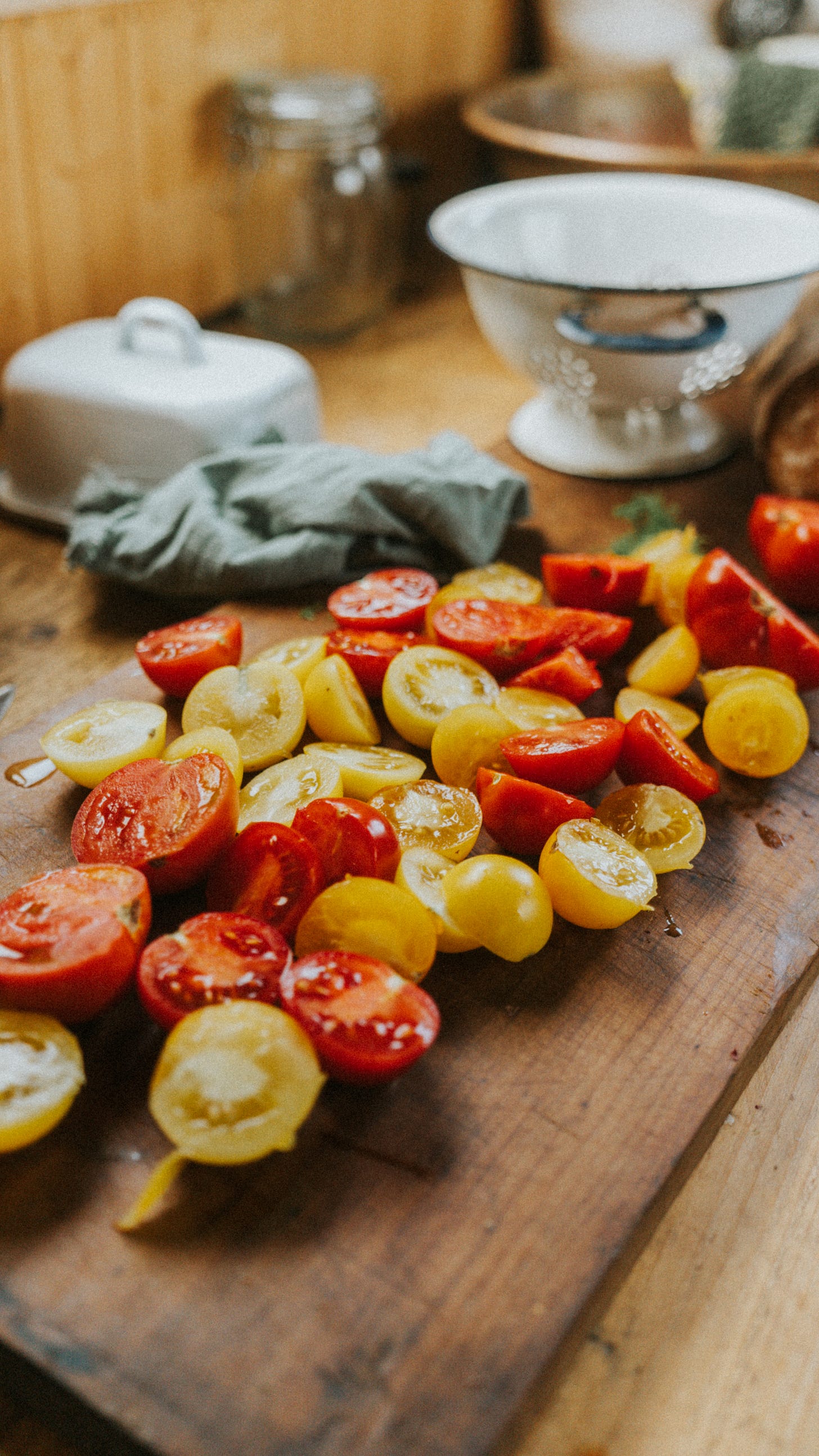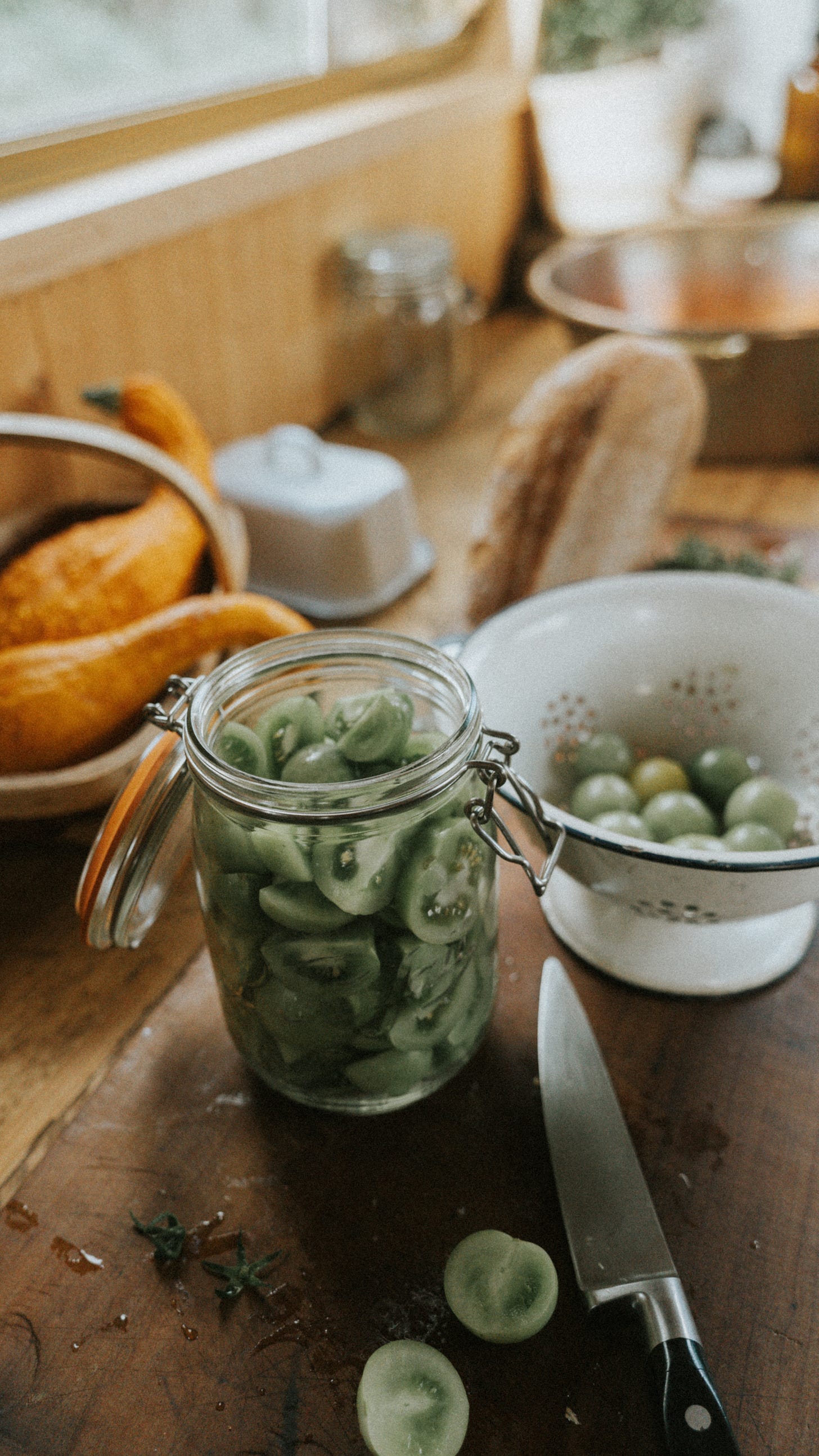Chilly days and the last of the tomatoes
Cosy season is officially here
I’ve tried to deny it. But, it’s here. The clues are everywhere. Socks, still soggy from this morning’s walk, are lurking near the stove and I’ve been told in no uncertain terms that the boot buffer zone has been established. They must not enter the boat any further than the welcome mat on which they currently sit, caked in mud and chiding away at the socks’ envious position. The weather has turned. Autumn is upon us.
Why then, is this edition of gather entirely about a fruit so ubiquitous to warmer days, that just one waft from the vine in my old, damp, allotment greenhouse can transport me straight to Campania? Before I can finally admit that summer has passed, it’s time to use up the last of the tomatoes.
This year has been a bit up and down for our tomato crop. The seedlings suffered in the chilly spring and the ones from the nursery went in far too late (reduced to 20p a plant kinda late). The only ones that have done well are a couple I picked up outside the supermarket. So well in fact, that they have turned into triffids. Stretching their fruit-laden arms behind and through various pieces of jagged metal inside the greenhouse. I know I should have pinched out, but I was quite impressed to see my new jungle grow… And who doesn’t love to feel like Percy Fawcett when planning a Panzanella for tea?
If you, like me, are left with a glut of green toms alongside the last few ripe stragglers, then I hope that the suggestions I have here help. The first is a recipe for my Fennel, Tomato and Butter Bean Stew. It’s a real delight especially, on a cold autumn day. Topped with fresh basil and some crumbled feta, it still has that little glimmer of summer.
The second is something I’m new to and have taken inspiration from Sam Cooper. Lacto-fermented green tomatoes that are so tangy and so full of flavour that no chutney will ever come near. After fermenting them, chop them finer and lob them on a burger or use them to make punchy salsa… Or simply spread ricotta on garlic-rubbed toast and plonk the tomatoes on top with a little drizzle of honey. Messy to eat, but bloody lovely!
Please do share your favourite way of using up the last few tomatoes and if these two ideas take your fancy, here are my recipes.
NB. This is our first week here on substack and so I’m keeping these available for all to see. However, in the future detailed recipes will only be available for premium members. We’d be so chuffed if you’d consider joining, as without your support we’d, quite frankly, be paddleless and in a very deep creek.
Tomato, Fennel and Butter Bean Stew w/ Basil and Feta.
Feeds 4 and takes around 35 to 40 minutes
Ingredients:
Olive oil - glug of
2x Red Onions - Chopped into little half-moons
1x Fennel Bulb - Cored, halved then sliced into crescents
1 tsp Fennel seeds
1/2 tsp Chilli flakes (depending on how hot you like it)
3x Cloves of garlic - Crushed
Red wine vinegar - Little splash to deglaze
Tomatoes - Around 20 halved and varying in colour and size. Keep a few back to add a little later in the recipe.
(if fresh tomatoes aren’t in season, a tin of chopped will do with a squirt of puree)
Butter beans - 570g jar (who doesn’t love the bold bean co) If not, then a 400g tin will be fine but not as creamy!
Big bunch of basil
Feta
Method:
Take a large lidded pan and place it on a medium heat with a glug of olive oil. Once the oil shimmers a little, add the onions and sliced fennel alongside a pinch of salt. Stir occasionally and cook until they become tender—around 8 minutes.
Next, add the fennel seeds, chilli flakes and garlic. Stir and cook for around 1 to 2 minutes more. Then chuck in a little splash of red wine vinegar to deglaze the pan.
Add the tomatoes next, holding back a handful for later. Reduce the heat to a low-medium and put the lid on the pan. Leave for around 12-15 minutes, giving a little stir every now and again to help the tomatoes break down and prevent any sticking.
Once the tomatoes are looking quite saucy, pour in the butter beans and their liquid. Cook with the lid off for about 5-10 more minutes so the stew starts to reduce and thicken a little. Then, add the remaining tomatoes to heat through.
Simmer for a few minutes more. Then season and stir in half of the chopped basil. Serve up and top each bowl with the crumbled feta, a little extra basil and a dribble of olive oil.
Lacto-Fermented Green Tomatoes
Just quickly, this is a process that *looks* complex written down. It’s really not too tricky so please don’t lose faith before trying them!
Equipment:
A clean fermentation jar - I used a classic Kilner/La Parfait with a clip top. These are ideal as they self-burp (I’ll explain more in the method) but any large jar will do… You’ll just need to remember to ‘belch’ it each day
Small piece of parchment paper - Around 8x8cm. Enough to cover the top of the tomatoes in the jar
A fermentation weight - I use a stone I picked up from the beach. I boiled it to sterilise. Or you can bespoke weights online
Kitchen scales - You need to weigh everything so you know how much salt to add.
A calculator - Unless you’re a maths whizz
Ingredients:
Green tomatoes - Enough so that when sliced they leave about an inch of room at the top of your jar
Salt - I use maldon. It needs to be non-iodised.
Water - tap is fine
Herbs/Spices - You can go wild here… For mine, I did two sliced cloves of garlic, a little dried chilli and a teaspoon of coriander seeds… Plus some fresh basil. It worked well. I’ve also got one on the go with fennel seed instead of the coriander.
Method:
Before doing anything, take your scales and weigh your empty jar. Write down the weight and re-tare your scales without the jar.
Next, decide on what flavours and spices you’re going to add. This really can be up to you. Just remember though, during the fermentation process the flavours will be enhanced. For my 1 litre jar, I go for 2 thinly sliced cloves of garlic, 1/2 a tsp of dried chilli flakes and a tsp of fennel or coriander seeds. Plus, a few leaves of fresh basil. Add these to the jar first.
Gently wash the green tomatoes and cut them into thin slices or quarters. Place them in the jar leaving a gap of about an inch at the top. Now, top the jar up with water so that all the tomatoes are covered.
Weigh the jar again and now it’s time to do a little maths…
Take the new weight and subtract from it the original weight of the empty jar.
Multiply the answer by 0.02. The result is how much salt we need to add.
For example… A my empty jar was 652g and the filled jar 1735g. I would do 1735 - 652 = 1083 . 1083 x 0.02 = 21.66g of salt
Measure out the salt into a small saucepan and add some of the water from the jar. It needs to be enough so that the salt completely dissolves. I find a gentle, low heat helps this. Keep stirring until it’s all gone.
Pour the salty water back into the jar. Clip the lid down and shake it gently to fully distribute all the ingredients. Now take your piece of parchment paper and place it on top of the tomatoes. For safe fermentation you need everything to stay submerged in the brine. Gently place a fermentation weight on top of the parchment paper.
Clip down the lid once more and place the jar in a spot away from direct sunlight. It’s worth putting it onto a plate as occasionally the fermentation can bubble over. Each day, belch your jar to release the build-up of gas. Just gently loosen the lid and retighten, you should see it bubbling and smell the gases escaping.
Over time, the tomatoes will become lighter in colour. Let them ferment for about a week, then taste. If you like the flavour then move the jar to the fridge or leave to ferment a little longer for it to become more tangy and acidic.
Kept in the fridge, this should keep for up to 4 months
If you enjoyed this post, please consider subscribing and maybe becoming a premium member.
It would also be amazing if you could share this post with anyone who you think would enjoy it. If you know a friend with a lot of leftover toms, please do tap the button to share this with them.
Thank you,
Jack xx






In the Pacific NW...green tomatoes can be plentiful. I have made tomato pie, tomato salt, roasted tomato sauce, pickled green tomato, and fried green tomatoes. One of my favorite green tomato explorations was green tomato jam. It was highly spiced and I called it Christmas Jam. Growing food makes one very adverse to waste. Food is special and precious. I am always searching for ways to reduce waste but still have my food pleasure. Thank you!
Great to see some green tomato fun happening, and what a lovely recipe too! Welcome to Substack! It’s lovely to see you here :)